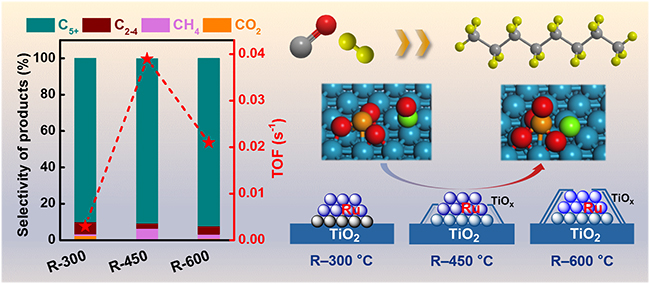Fischer–Tropsch synthesis (FTS) offers a powerful way to realize the transformation of nonpetroleum resources to syngas and further to high value-added chemicals and fuels.
Late transition metals like Fe, Co and Ru are widely used to facilitate this process. Ru is identified to be intrinsic of high activity and selectivity in FTS. Due to the high price of Ru, there is an urgent need to develop highly efficient Ru-based catalysts with high dispersion.
The utilization of strong metal–support interaction (SMSI) has been demonstrated to be an alternative strategy to enhance the catalytic reactivity of metal catalysts in FTS, while the catalytic role of the metal–support interface remains unclear.
Recently, a group led by Prof. HUANG Yanqiang and Prof. ZHANG Tao from the Dalian Institute of Chemical Physics (DICP) of the Chinese Academy of Sciences developed highly efficient Ru/TiO2 nanocatalyst for FTS, and discovered that the TiOx overlayer at Ru/TiO2 interface directly involves in the catalytic mechanism of FTS to facilitate the CO bond dissociation.

Catalytic performance and structural evolution of the Ru/TiO2 at different stages of reduction (Image by ZHANG Yaru)
Benefiting from the lattice matching of RuO2 and rutile TiO2, the highly dispersed Ru/TiO2 nanocatalyst with an average diameter of approximately 2 nm could be facilely acquired. The small sized Ru nanoparticles (NPs) manifest sintering resistance even under 600°C reduction treatment.
The researchers found that by varying the reduction condition to regulate the TiOx overlayer on the Ru NPs, the catalytic activity of the Ru/TiO2 nanocatalyst in FTS could be boosted, which was superior to other Ru-based catalysts reported previously.
With various characterizations and theoretical modeling, the reduced TiOx overlayer on Ru/TiO2 nanocatalyst wass demonstrated to participate in and dramatically facilitate the bond cleavage of CO.
This study provides a deep insight on the mechanism of TiOx overlayer in FTS, and offers an effective approach to tuning catalytic reactivity of metal nanocatalysts on reducible oxides.
The study was published in Nature Communications on June 24.
This work was supported by the National Key R&D Program of China, the National Natural Science Foundation of China, and the Strategic Priority Research Program of the Chinese Academy of Sciences. (Text by ZHANG Yaru)